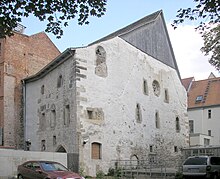Old Synagogue (Erfurt)
| Old Synagogue, Erfurt | |
|---|---|
 | |
| Religion | |
| Affiliation | Judaism |
| Rite | Nusach Ashkenaz |
| Status | Museum |
| Location | |
| Location | Erfurt |
| Country | Germany |
| Geographic coordinates | 50°58′43.06″N 11°1′45.43″E / 50.9786278°N 11.0292861°E |
| Architecture | |
| Architectural type | Synagogue |
| Architectural style | Romanesque |
| Website | |
| Old Synagogue, Erfurt | |
The Old Synagogue (German:Alte Synagoge) in Erfurt, in central Germany, is one of the best preserved medieval synagogues in Europe. The oldest parts were built in the late 11th century. Most parts of the building are from around 1250 to 1320. In 2015 it was proposed as a World Heritage Site.[1]
It has been a museum of local Jewish history since 2009. The Erfurt Treasure is kept there. This is a collection of medieval coins, jewellery and metalwork found in 1998. The museum also has copies of the Erfurt Hebrew Manuscripts. This is a collection of rare religious manuscripts that belonged to the Jewish community of Erfurt in the middle ages.[2][3]
History and preservation[change | change source]
The oldest parts of the building date from 1094. About 1270 a larger synagogue, which included parts of the older building, was built. The western wall of the building dates from this time. It has its six original windows. Another storey was added in the early 1300s.[1]
In 1349, many people died from the Black Death disease. People said it was the fault of the Jews. The Jews were murdered and made to leave the city. This pogrom is known as the Erfurt Massacre. The synagogue was damaged and Erfurt City Council took control of the building. They later sold it to a local business man. He used it as a warehouse and made changes to the interior, including building a cellar. For the next 500 years it was used for storing goods.[1][4]
From the 19th century, the building was used as a ballroom, a restaurant and even a bowling alley. These changes meant that the Old Synagogue was mostly forgotten about. Its history was not recognised, which helped to protect it during the Nazi period.[1][4]
In the late 1980s there was renewed interest in the old building. The architectural historian Elmar Altwasser began to research it in 1992. Erfurt City Council bought the property in 1998 and researched and conserved it. All stages of the building's history were conserved, not just its use as a Synagogue.[1]
In 2007 a rare and well-preserved Jewish ritual bath, a Mikveh, was discovered not far from the Old Synagogue by archaeologists. It was built about 1250.[5]
In 2015 the Old Synagogue and Mikveh, and a stone house in Erfurt's medieval city centre, also built around 1250 that had belonged to Jews, were proposed as a World Heritage Site. This has been provisionally listed but no final decision has been made.[6][1]
Museum[change | change source]
The Old Synagogue opened as a museum on 27 October 2009.[4]
The Erfurt Treasure is displayed in the museum. This is a collection of coins, jewellery and metalwork that is thought to have belonged to Jews who hid them at the time of the Erfurt massacre in 1349. It was found in 1998 in the wall of a house in a medieval Jewish neighbourhood in Erfurt.[2]
The museum also displays copies of the Erfurt Hebrew Manuscripts. This is a collection medieval manuscripts written from the 12th to the 14th centuries. They came into the possession of the Erfurt City Council after the Erfurt Massacre in 1349. They were kept at the library at St. Augustine's Monastery in Erfurt from the mid 17th century. In 1880 they were sold to the Royal Library in Berlin, which is now the Berlin State Library. The original manuscripts are kept there.[3]
Erfurt Tosefta[change | change source]
One of the Erfurt Manuscripts is the Tosefta, dating from the 12th century. The Tosefta is a collection of ancient jewish oral laws collected by scholars in the first 200 years AD. Copies of Tosefta were not made very often. The Erfurt Tosefta is the oldest of only three known Tosefta manuscripts. It was written in the 12th century. The other two Tosefta manuscripts are the Vienna Tosefta, made in the late 13th century, held by the Austrian National Library and the London Tosefta, made in 15th century, held by the British Library.[7][8]
Moses Samuel Zuckermandel was the first person to point out the importance of the Erfurt Tosefta. He published an important study on it in 1876.[7][9]
References[change | change source]
- ↑ 1.0 1.1 1.2 1.3 1.4 1.5 Permanent Delegation of Germany to UNESCO (2015) Old synagogue and Mikveh in Erfurt - UNESCO world heritage centre. Retrieved 4 June 2017
- ↑ 2.0 2.1 Jewish life in Erfurt. Erfurt Treasure. Retrieved 3 June 2017
- ↑ 3.0 3.1 Jewish life in Erfurt. Erfurt Hebrew Manuscripts. Retrieved 4 June 2017
- ↑ 4.0 4.1 4.2 Jewish Life in Erfurt. Old synagogue. Retrieved 31 October 2016
- ↑ Deutsche Welle (24th April 2007). Archeologists discover medieval Jewish bath in Erfurt. Retrieved 31 October 2016.
- ↑ Jewish life in Erfurt. The Stone House. Retrieved 10 June 2016
- ↑ 7.0 7.1 Erfurt Collection: Erfurt Hebrew Manuscripts. Retrieved 8 June 2017
- ↑ My Jewish Learning - Mishnah and Tosefta. Retrieved 9 June 2017
- ↑ Zuckermandel, M. S. (1876) Die Erfurter Handschrift der Tossefta: Beschrieben und geprüft von Dr. M. S. Zuckermandel, Berlin: Louis Gerschel Verlagsbuchhandlung
Other websites[change | change source]
- Permanent Delegation of Germany to UNESCO (2015) Old synagogue and Mikveh in Erfurt - UNESCO world heritage centre.
- Jewish Life in Erfurt. Old synagogue
- Jewish life in Erfurt. Erfurt Treasure
- Jewish life in Erfurt. Erfurt Hebrew Manuscripts
- Jewish life in Erfurt. Mikveh

